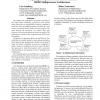Free Online Productivity Tools
i2Speak
i2Symbol
i2OCR
iTex2Img
iWeb2Print
iWeb2Shot
i2Type
iPdf2Split
iPdf2Merge
i2Bopomofo
i2Arabic
i2Style
i2Image
i2PDF
iLatex2Rtf
Sci2ools
98
Voted
IPPS
1998
IEEE
1998
IEEE
Comparing the Optimal Performance of Different MIMD Multiprocessor Architectures
We compare the performance of systems consisting of one large cluster containing q processors with systems where processors are grouped into k clusters containing u processors each. A parallel program, consisting of n processes, is executed on this system. Processes may be relocated between the processors in a cluster. They may, however, not be relocated from one cluster to another. The performance criterion is the completion time of the parallel program. We present two functions: g(n,k,u,q) and G(k,u,q). Provided that we can find optimal or near optimal schedules, these functions put optimal upper bounds on the gain of using one cluster containing q processors compared to using k clusters containing u processors each. The function g(n,k,u,q) is valid for programs with n processes, whereas G(k,u,q) only depends on the two multiprocessor architectures. By evaluating g(n,k,u,q) and G(k,u,q) we show that the gain of increasing the cluster size from 1 to 2 and from 2 to 4 is relatively la...
Related Content
| Added | 25 Aug 2010 |
| Updated | 25 Aug 2010 |
| Type | Conference |
| Year | 1998 |
| Where | IPPS |
| Authors | Lars Lundberg, Håkan Lennerstad |
Comments (0)

